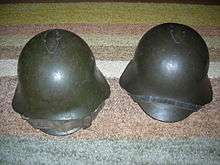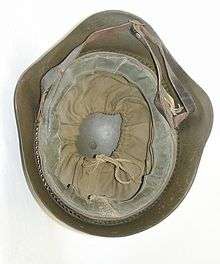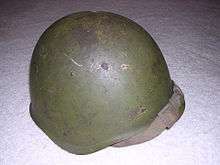Soviet helmets during World War II
Over the course of World War II the Soviet Union employed three main helmet designs; the M-36, the SSh-39, and the SSh-40, each being designated with the year in which they were introduced. Standard practice was to stamp the size, location, and year of manufacturing on the interior of the helmet.
Adrian

The French Adrian helmet was used by the Imperial Russian and then the Red Army until the M36 started entering service. However large stockpiles were kept and were issued during the mobilisation, especially to second line units.
M-36


The M (model, or model) 36 was designed by Aleksandr A. Shvartz, and began production in 1936. Its large front rim and wide flares over the ears provided good protection for the wearer. The German M35, introduced a year before the Russian M-36, served as a model for the development of the M-36. The M-36 was also fitted with a comb on top, which allowed for ventilation. There were also apocryphal claims that the comb was designed to deflect saber blows.
Early M-36s were made with fragile leather linings. Due to the unreliability of these early models containing leather linings, later variations were introduced with cloth linings. Similar problems were also encountered with early leather chinstraps, so the leather chinstraps were phased out in favor of cloth models as well. Throughout their production four sizes were produced: small, medium, large, and extra large.
The M-36 was worn by Soviet soldiers in several campaigns of the late 1930s and 1940s, including the Khalkin Gol campaign against the Japanese in 1939 (giving it the nickname "Khalkingolka"),[1] the Finnish Winter War of 1939-1940, the 1939 invasion of Poland, the 1940 invasions of the Baltic states and Bessarabia, and in World War II, or as it is known in Russia, the Great Patriotic War. It was also distributed to the Republican soldiers of the Spanish Civil War in conjunction with Soviet support of the Spanish government. During the Finnish Winter War, the cold temperatures forced many soldiers to tear out the helmet's liner so the ushanka, or fur hat, would fit under the metal shell.
Production of the M-36 ended in 1941. Today it is a rare and expensive item for its collectors.
SSh-39

The SSh (stalnoy shlem, or steel helmet) 39 was of simple, more modern design, and was much easier to manufacture than the M36. The SSh-39 would be the standard design for Soviet helmets for the next 29 years, with only minor changes occurring during that time. It is also the design for the helmet on the Tomb of the Unknown Soldier in Moscow. The helmet was produced primarily in three factories, the Stalingrad Tractor Factory (designated CT in the ink stamp), the Red October Factory (3K0) also in Stalingrad, and the Lysva Metallurgical Factory (LMZ).[2] The first liner was an eight-finger leather liner, similar to the German M35-M42. Next came a short production of an eight-finger liner made of Gralex. The final version of the SSh-39 liner was cloth, similar to the M-36 liner. All three variations of the liner were suspended from the helmet by three metal tabs, which were riveted to the shell near the top. This helmet, like the M-36, saw action in numerous campaigns before it was phased out in 1942 in favor of the SSh-40.
SSh-40
The SSh-40 was the last and most commonly seen in-service helmet used by the Soviet Union during World War II. The only external difference between the SSh-39 and the SSh-40 were the six rivets near the bottom of the helmet, as opposed to the three near the top of the SSh-39 shell. Rivet placement of the SSh-40 was due to a newly introduced liner, simpler and more sturdy than the previous versions. The liner consisted of three (later four during post-war) cloth or oilcloth pads connected with a cotton drawstring for size adjustment. The chinstrap was cloth and connected to d-rings on each side of the shell by tabs. The chinstrap ends were connected with a slip buckle, and a semi-circular metal piece was clamped to the end of the long chinstrap. Unlike the M-36 and SSh-39, the SSh-40 was only manufactured in three sizes, 1–3. The SSh-40 was supplemented by the SSh-60 and finally replaced by the SSh-68.
References
| Wikimedia Commons has media related to Soviet military helmets. |